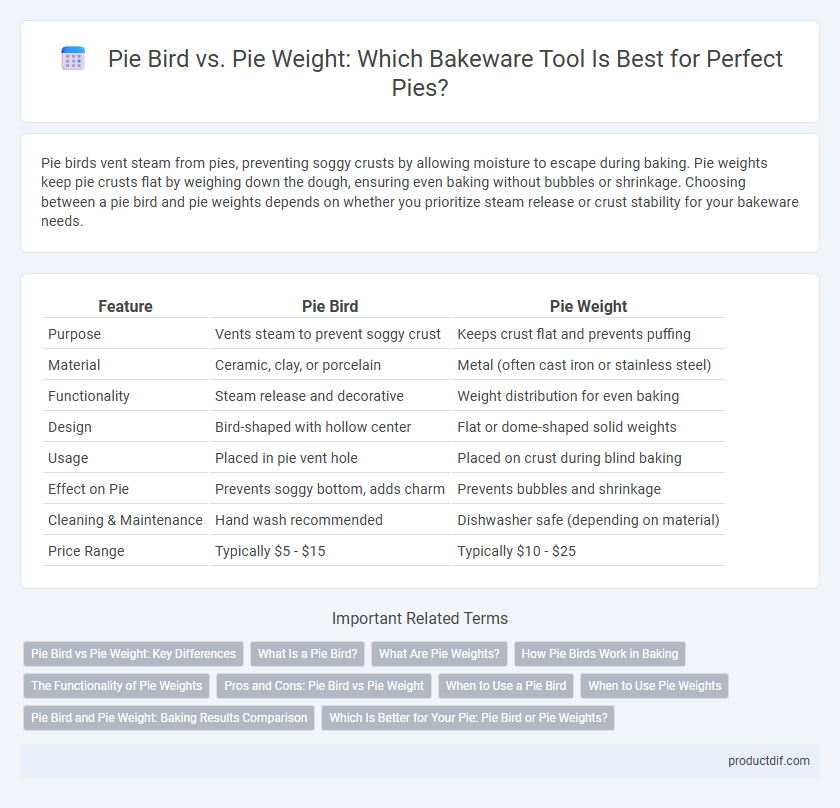Pie birds vent steam from pies, preventing soggy crusts by allowing moisture to escape during baking. Pie weights keep pie crusts flat by weighing down the dough, ensuring even baking without bubbles or shrinkage. Choosing between a pie bird and pie weights depends on whether you prioritize steam release or crust stability for your bakeware needs.
Table of Comparison
| Feature | Pie Bird | Pie Weight |
|---|---|---|
| Purpose | Vents steam to prevent soggy crust | Keeps crust flat and prevents puffing |
| Material | Ceramic, clay, or porcelain | Metal (often cast iron or stainless steel) |
| Functionality | Steam release and decorative | Weight distribution for even baking |
| Design | Bird-shaped with hollow center | Flat or dome-shaped solid weights |
| Usage | Placed in pie vent hole | Placed on crust during blind baking |
| Effect on Pie | Prevents soggy bottom, adds charm | Prevents bubbles and shrinkage |
| Cleaning & Maintenance | Hand wash recommended | Dishwasher safe (depending on material) |
| Price Range | Typically $5 - $15 | Typically $10 - $25 |
Pie Bird vs Pie Weight: Key Differences
Pie birds and pie weights serve distinct baking purposes; pie birds ventilate steam by releasing it through the crust, preventing sogginess and ensuring a crisp bottom. Pie weights, made of ceramic or metal beads, weigh down the dough during blind baking, preventing bubbles and shrinkage to maintain an even crust shape. Choosing between a pie bird and pie weights depends on whether the goal is ventilation for vented pies or stabilization for crust structure during pre-baking.
What Is a Pie Bird?
A pie bird is a ceramic or metal venting tool placed in the center of a pie to allow steam to escape during baking, preventing the crust from becoming soggy and helping to maintain pie shape. Unlike pie weights, which are used to weigh down pastry in blind baking, pie birds serve the specific purpose of ventilation and add a charming, traditional touch to homemade pies. Their design often resembles a bird with an open beak, allowing steam to rise through while baking.
What Are Pie Weights?
Pie weights are small, heat-resistant objects, often made from ceramic, metal, or silicone, used during blind baking to prevent pie crusts from puffing or shrinking. Unlike pie birds, which vent steam from the pie while baking, pie weights ensure an even, flat crust by distributing pressure evenly over the dough. Using pie weights helps achieve a crisp and perfectly shaped crust for custard or cream pies that require pre-baking.
How Pie Birds Work in Baking
Pie birds function as venting tools in baking, allowing steam to escape through the bird-shaped chimney during the pie's cooking process. This prevents the filling from bubbling over and helps maintain a crisp, flaky crust by reducing sogginess caused by trapped steam. Unlike pie weights, which keep the crust flat during blind baking, pie birds actively manage moisture and air flow, ensuring even cooking and a visually appealing pie.
The Functionality of Pie Weights
Pie weights are essential for preventing pie crusts from puffing up or shrinking during blind baking by evenly distributing heat and maintaining the crust's shape. Unlike pie birds, which allow steam to escape through a vent, pie weights keep the dough flat and crisp without creating a vent hole. This functionality ensures a perfectly baked crust, ideal for custard or cream pies that require a fully cooked base before filling.
Pros and Cons: Pie Bird vs Pie Weight
Pie birds excel in venting steam, preventing soggy crusts and boil-overs during baking, while pie weights ensure even crust baking by preventing shrinkage and bubbles. Pie birds offer a decorative, reusable steam vent but may be less effective in heavy-duty crust stabilization compared to pie weights, which require extra cleanup after use. Choosing between them depends on the desired balance between aesthetic appeal and practical crust management in bakeware.
When to Use a Pie Bird
A pie bird is ideal when baking fruit pies with a high moisture content to vent steam and prevent soggy crusts. Unlike pie weights, which keep the crust flat during blind baking, pie birds allow steam to escape, reducing the risk of bubbling and cracking. Use a pie bird when you want a decorative vent that improves airflow without flattening the dough.
When to Use Pie Weights
Pie weights are ideal when blind baking pie crusts to prevent bubbling and shrinking, especially for custard or cream pies that require a fully baked shell. Unlike pie birds, which vent steam and reduce sogginess, pie weights ensure an even, flat crust surface without collapsing. Use pie weights when you need a crisp, firm crust before adding wet fillings to maintain structure and texture.
Pie Bird and Pie Weight: Baking Results Comparison
Pie birds effectively vent steam during baking, preventing soggy crusts and ensuring a golden, flaky texture. Pie weights help maintain the crust's shape by preventing bubbling and shrinking when blind baking, resulting in an evenly crisp base. Comparing the two, pie birds enhance overall pie structure and moisture control, while pie weights excel in preserving crust integrity during pre-baking.
Which Is Better for Your Pie: Pie Bird or Pie Weights?
Pie birds and pie weights serve distinct purposes for ensuring a perfect pie crust. Pie birds vent steam during baking, preventing soggy crusts and bubbling filling, while pie weights keep the crust flat and prevent shrinking or puffing during blind baking. Choosing between them depends on your recipe: use pie birds for fruit pies needing steam release, and pie weights for custard or cream pies requiring a crisp, evenly baked base.
Pie bird vs Pie weight Infographic

 productdif.com
productdif.com